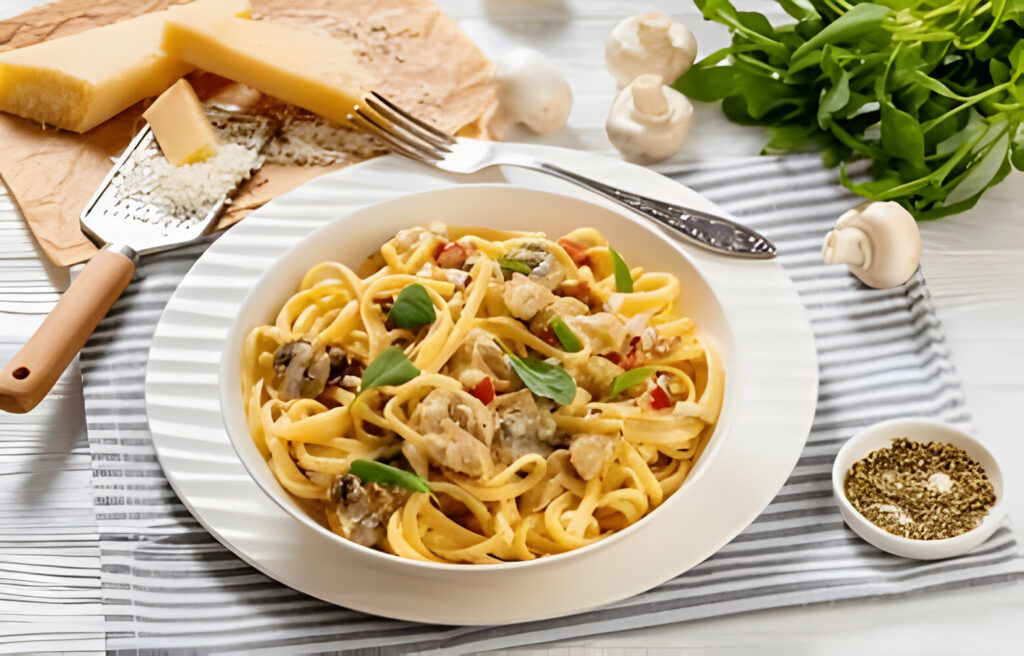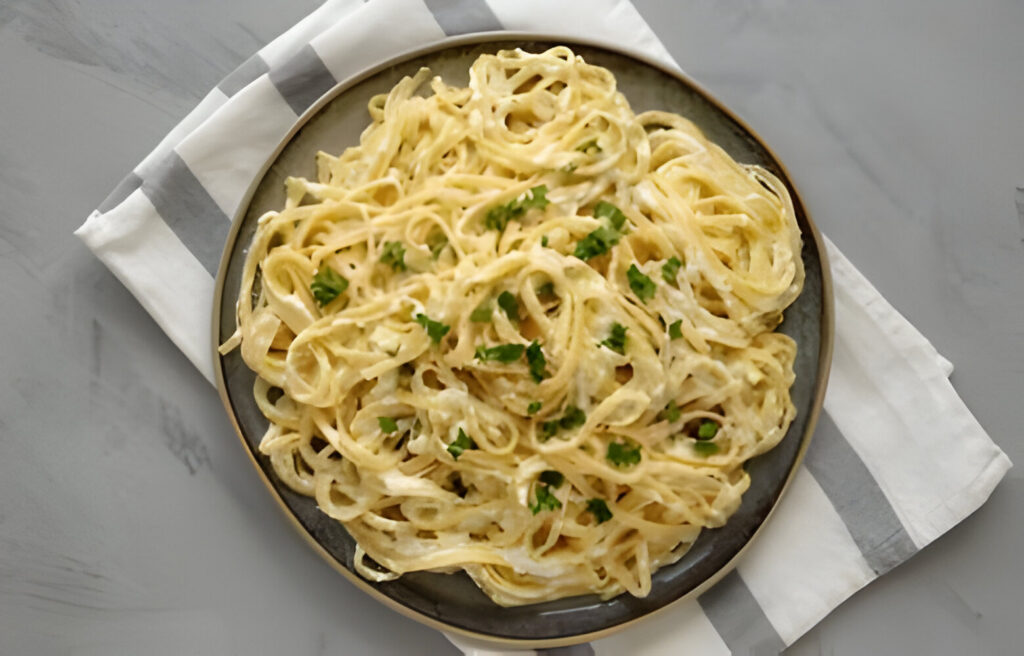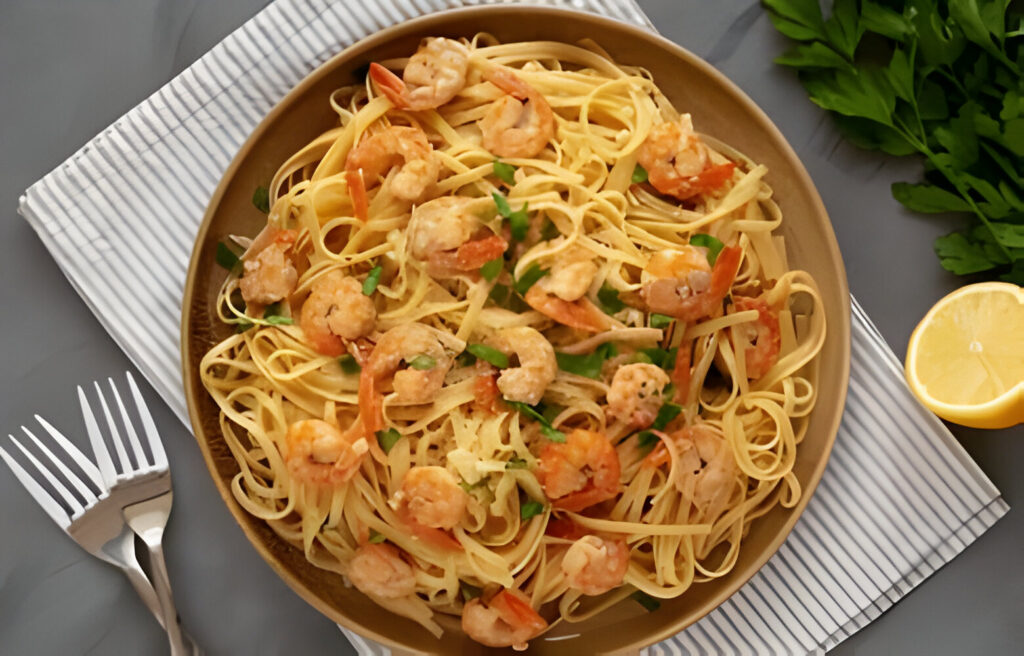
Introduction to Linguine: A Staple of Italian Cuisine
The Essence of Linguine
Linguine, often celebrated as a culinary delight, stands out in the rich tapestry of Italian cuisine. Originating from the beautiful coastlines of Italy, linguine—which translates to “little tongues” in Italian—boasts a long, flat shape. This pasta variety, slightly wider than spaghetti but not as wide as fettuccine, has captured the hearts of food enthusiasts worldwide. Its unique texture and shape make it the perfect candidate for a myriad of sauce pairings, from the light and zesty to the rich and creamy.
A Brief History
Delving into the origins of linguine unveils a journey back to the Genoa and Liguria regions of Italy. Historically, linguine has roots that intertwine with the maritime culture of these areas, reflecting a preference for seafood dishes. The pasta’s design, ideal for clinging onto sauces, particularly complements the region’s abundant seafood, offering a delightful culinary experience. Over the years, linguine has transcended regional boundaries, securing a beloved place in international cuisine.
Linguine vs. Other Pasta
Understanding the distinction between linguine and its pasta counterparts is crucial for both novice and seasoned cooks. While its silhouette resembles that of spaghetti, linguine’s flatter edge allows it to hold sauces more effectively, ensuring each bite is flavorful. This characteristic sets it apart from rounder pasta types, highlighting its versatility in the kitchen. Whether tossed in a simple garlic and olive oil sauce or combined with a hearty seafood medley, linguine serves as a versatile base for a plethora of dishes.
Why Linguine Deserves a Spot in Your Kitchen
Incorporating linguine into your culinary repertoire opens up a world of flavor possibilities. Its adaptability with various ingredients—from sun-dried tomatoes to fresh basil and succulent prawns—makes it a go-to option for quick weeknight dinners and elaborate feasts alike. Furthermore, mastering the art of cooking linguine to perfection, achieving that ideal al dente texture, can elevate your cooking game. Thus, embracing linguine not only enriches your dining experience but also enhances your skills as a home chef.
Conclusion
Linguine, with its rich heritage and culinary flexibility, rightfully earns its status as a staple of Italian cuisine. Its unique shape and ability to marry well with diverse sauces make it a beloved choice for pasta lovers. As we dive deeper into the world of linguine, remember that this pasta does more than fill a plate—it brings a piece of Italian tradition into our homes. Embracing linguine in your kitchen means welcoming a blend of history, flavor, and artistry onto your dining table.

The Ingredients: What You Need for Perfect Linguine
Choosing Your Linguine
Selecting the right type of linguine is the first step to culinary success. For an authentic experience, opt for high-quality, dried Italian linguine. These often contain durum wheat semolina, known for its robust flavor and al dente texture. However, for those with dietary restrictions, numerous alternatives exist. Gluten-free options made from rice or corn flour and whole wheat versions for a fiber-rich choice are readily available. Each variety brings its unique texture and taste to the table, catering to diverse preferences and health requirements.
Essential Ingredients for a Classic Linguine Dish
The beauty of linguine lies in its simplicity. A classic linguine dish requires only a handful of quality ingredients. Start with extra virgin olive oil, a staple in Italian cooking, known for its fruity notes and health benefits. Fresh garlic and red pepper flakes provide the base flavors, offering a balance of heat and aroma. For a traditional twist, incorporate fresh clams or prawns, enhancing the dish with a taste of the sea. Lastly, don’t forget fresh parsley and grated Parmesan cheese for garnishing, adding freshness and depth to the dish.
Incorporating Fresh Produce
Fresh produce can elevate your linguine dish from good to exceptional. Cherry tomatoes, zucchini, and spinach add color, vitamins, and flavors. When selecting vegetables, aim for seasonal and locally sourced options. They not only taste better but also support sustainable practices. Fresh herbs like basil and oregano, added towards the end of cooking, maintain their vibrant flavors and aromas, infusing the dish with Italian authenticity.
The Importance of Seasoning
Seasoning is crucial in bringing out the natural flavors of your ingredients. Sea salt and freshly ground black pepper are essentials that should be used judiciously to enhance, not overpower, the delicate taste of linguine and its accompaniments. For those looking to experiment, a dash of lemon zest or juice can add a refreshing twist, brightening the overall flavor profile of the dish.
Conclusion
Preparing the perfect linguine dish starts with selecting the right ingredients. From the pasta itself to the fresh produce and seasonings, each component plays a pivotal role in creating a harmonious and flavorful dish. By focusing on quality and freshness, you set the stage for a culinary experience that celebrates the simplicity and richness of Italian cuisine. Whether you’re a seasoned chef or a novice in the kitchen, these guidelines will help you craft a linguine dish that delights the senses and brings a taste of Italy to your table.
Step-by-Step Linguine Cooking Guide
Preparing the Linguine
Cooking linguine to perfection begins with boiling water. Start by filling a large pot with water, allowing plenty of space for the pasta to move freely. For every pound of pasta, use about 4 quarts of water. As the water heats, add a generous pinch of salt. This is crucial for flavoring the pasta from the inside out. Once the water reaches a rolling boil, add the linguine, stirring gently to prevent sticking. The key to perfectly cooked linguine is to follow the package’s recommended cooking time, usually between 8 to 10 minutes, to achieve al dente texture—tender yet firm to the bite.
Monitoring the Cooking Process
As the linguine cooks, it’s important to stir occasionally, ensuring even cooking and preventing clumps. Use a timer to avoid overcooking, as pasta can quickly progress from al dente to mushy. Around the 7-minute mark, start checking the pasta by tasting a strand. It should be slightly resistant in the center. Remember, the pasta will continue to cook a bit after it’s drained, especially if it’s going back into a hot pan with sauce.
Draining and Serving
Once the linguine reaches the perfect al dente texture, drain it promptly. Reserve a cup of pasta water before draining—this starchy liquid is a secret weapon for adjusting the consistency of your sauce. After draining, avoid rinsing the pasta. Rinsing cools the pasta down and removes the surface starch that helps sauces cling. If not tossing with sauce immediately, drizzle a bit of olive oil and toss to prevent sticking.
Pairing with Sauce
The final step is to combine your linguine with the sauce. If the sauce is ready in a skillet, add the drained pasta directly to it. Toss over low heat for a minute or two, allowing the pasta to absorb the flavors. If the sauce seems thick, add reserved pasta water, a little at a time, until you achieve the desired consistency. This integration step is crucial for marrying the pasta with its sauce, ensuring each strand is beautifully coated and flavorful.
Conclusion
Mastering the art of cooking linguine is about attention to detail—from boiling water preparation to the final toss in sauce. By following these steps, you ensure a perfectly cooked pasta dish that retains its texture and enhances the overall flavor of your meal. Remember, great pasta dishes start with the basics: quality ingredients, precise timing, and the right techniques. With this guide, you’re well on your way to serving up delicious linguine dishes that rival those of any Italian restaurant.

The Perfect Sauce Pairing for Your Linguine
Understanding Sauce Pairings
Choosing the right sauce for your linguine can transform a simple meal into an extraordinary culinary experience. The flat, narrow strands of linguine are particularly suited to lighter, oil-based sauces or seafood concoctions. This compatibility is due to the pasta’s ability to hold onto the sauce, ensuring each bite is as flavorful as the last. Let’s explore some classic sauce pairings that will elevate your linguine dish.
Tomato Basil Sauce: A Classic Choice
A simple yet delightful tomato basil sauce serves as a timeless companion to linguine. Begin with ripe, juicy tomatoes or high-quality canned San Marzano tomatoes for consistency. Sauté garlic in olive oil until fragrant, then add the tomatoes, crushing them lightly. Simmer to enhance the flavors, then finish with fresh basil leaves and a drizzle of extra virgin olive oil. This sauce balances the richness of the tomatoes with the freshness of basil, creating a harmonious blend that complements the texture of linguine.
Creamy Alfredo Sauce: For a Richer Taste
For those who prefer a creamier texture, Alfredo sauce is a sumptuous option. Start with butter and garlic, cooking gently to avoid browning. Whisk in heavy cream and bring to a simmer. Gradually add grated Parmesan cheese until the sauce thickens and becomes velvety. Season with a pinch of nutmeg, salt, and pepper to taste. Alfredo sauce’s creamy consistency clings beautifully to linguine, offering a rich and indulgent dish.
Seafood Sauce: Elevating Linguine to New Heights
Seafood sauce, with its light and aromatic qualities, is particularly well-suited to linguine. This sauce often features clams, mussels, shrimp, or a combination, cooked in a white wine and garlic broth. The key is to use fresh seafood and to cook it just until done, preserving its delicate flavor and texture. Fresh parsley and a squeeze of lemon juice added at the end brighten the dish, enhancing its complexity. This pairing showcases the natural affinity between linguine and seafood, bringing the tastes of the Italian coastline to your table.
Conclusion
Selecting the perfect sauce for your linguine is crucial in crafting a memorable dish. Whether you opt for the simplicity of a tomato basil sauce, the richness of Alfredo, or the elegance of a seafood sauce, the key is to use fresh, quality ingredients. By following these guidelines and experimenting with different sauce pairings, you can create a range of linguine dishes that cater to various tastes and occasions. So, grab your apron and let the magic of sauce and pasta come together in your kitchen.
How to Serve and Present Your Linguine
Plating Your Dish
The presentation of your linguine can significantly enhance the dining experience. Begin by selecting a flat, wide plate or bowl. This choice allows the linguine and its accompanying sauce to spread out, showcasing the dish’s vibrant colors and textures. Use tongs to twirl a serving of linguine into the center of the plate, creating height and focus. This method not only makes the dish visually appealing but also ensures that the pasta and sauce are evenly distributed.
Garnishing for Flavor and Color
Garnishes play a crucial role in finishing the dish, adding both flavor and visual appeal. Fresh herbs, such as basil or parsley, add a pop of color and a burst of freshness. A sprinkle of grated Parmesan or Pecorino cheese introduces an element of richness and depth. For a touch of brightness, consider a zest of lemon or a light drizzle of high-quality olive oil. These final touches not only enhance the dish’s presentation but also complement the flavors of the sauce and pasta.
Accompaniments to Complete the Meal
While linguine can stand alone as a satisfying meal, the right accompaniments can elevate it to a full dining experience. A simple side salad, dressed with a light vinaigrette, adds freshness and balances the richness of the pasta. For a heartier meal, consider serving garlic bread or focaccia on the side. These bread options are perfect for sopping up any remaining sauce, ensuring that none of the delicious flavors go to waste. In choosing accompaniments, aim for balance and harmony with the main dish, enhancing rather than overshadowing the linguine.
Conclusion
Serving and presenting your linguine with care turns a simple meal into an elegant dining experience. From the choice of plate to the final garnish, each element should aim to highlight the dish’s flavors and beauty. By following these tips for plating, garnishing, and selecting accompaniments, you can transform your linguine into a feast for both the eyes and the palate. Remember, the art of presentation is just as important as the cooking process, making every bite a memorable one.
Tips and Tricks for Mastering Linguine
Achieving the Perfect Al Dente Texture
One of the hallmarks of a great linguine dish is its al dente texture. Achieving this requires precision. Start by boiling your pasta in salted water. Keep a close eye on the cooking time, and begin taste-testing a minute before the package suggests. Remember, the pasta continues to cook even after it’s removed from the water. Therefore, draining it when it’s still slightly firmer than you’d like ensures it reaches that perfect al dente texture as it cools.
Enhancing Flavor with Pasta Water
Don’t discard the water used to boil your linguine. This starchy liquid is a valuable asset for creating silky, well-emulsified sauces. After draining your pasta, add a splash of the reserved water to your sauce. It helps the sauce cling to the pasta more effectively, ensuring each strand is evenly coated and delicious.
Experimenting with Ingredients
While traditional linguine recipes are timeless, don’t be afraid to experiment. Incorporating seasonal vegetables, swapping proteins, or adding unexpected spices can transform a familiar dish into something exciting and new. The versatility of linguine makes it an ideal canvas for culinary creativity. Start with small adjustments to see how different flavors and textures interact.
Storing and Reheating Leftovers
If you have leftover linguine, store it properly to maintain its texture and flavor. Cool it down quickly and refrigerate in an airtight container. When reheating, a splash of water and a few minutes over medium heat can revive the dish. Avoid using high heat or microwaving for too long, as this can make the pasta mushy.
Conclusion
Mastering linguine requires attention to detail, from cooking it perfectly al dente to experimenting with diverse ingredients. By applying these tips and tricks, you can elevate your pasta dishes to new culinary heights. Remember, great cooking is not just about following recipes—it’s about using them as a foundation for exploration and creativity. So, embrace the process and enjoy the delicious results.
Conclusion: Bringing It All Together
Celebrating Linguine in Your Kitchen
Embarking on a culinary journey with linguine offers an opportunity to explore the richness of Italian cuisine right in your kitchen. From selecting the perfect type of linguine to mastering the art of sauce pairing, each step is a building block towards creating dishes that resonate with authenticity and flavor. Remember, the essence of cooking linguine lies in the balance between simplicity and creativity.
Embracing the Art of Cooking
As we’ve explored, achieving the perfect al dente texture, experimenting with fresh ingredients, and even mastering the art of reheating leftovers are all part of the joy of cooking linguine. These tips and tricks not only enhance your culinary skills but also invite you to innovate and personalize each dish to your taste. Cooking is an art, and linguine serves as a versatile canvas for your culinary expressions.
Encouraging Culinary Exploration
We encourage you to use this guide as a foundation for your linguine dishes, inviting you to explore beyond the traditional. Incorporate seasonal produce, try new sauce recipes, and don’t shy away from adding your unique twist to the classics. The journey of cooking is endless, filled with discoveries and delights at every turn.
Frequently Asked Questions
How Much Water Should I Use to Cook Linguine?
For the best results, use about 4 quarts of water for every pound of linguine. This ensures the pasta has enough room to cook evenly and prevents sticking. Remember, starting with ample water is key to achieving perfectly cooked linguine.
Can I Add Oil to the Pasta Water?
While some people suggest adding oil to prevent sticking, it’s not necessary. Instead, stir your linguine frequently during the first minutes of cooking. This step is more effective at keeping the pasta from clumping together. Oil can actually make it harder for sauce to cling to the pasta later.
How Do I Know When Linguine is Perfectly Cooked?
Linguine is perfectly cooked when it is al dente, or firm to the bite. Start checking the pasta about 2 minutes before the package’s suggested cooking time. The pasta should feel slightly firm in the center. Remember, it will continue to cook a bit after you drain it.
How Can I Prevent My Linguine from Sticking After Draining?
To prevent sticking, toss the drained linguine with a bit of sauce immediately after draining. If you’re not ready to add sauce, a quick toss with olive oil can also help. However, avoid letting the pasta sit for too long without any moisture.
Can I Use Gluten-Free Linguine in Any Recipe?
Yes, you can substitute gluten-free linguine in most recipes. Be aware that the cooking time might differ, so adjust accordingly. Gluten-free pasta often requires more attention during cooking to prevent it from becoming mushy. Always start with the package’s instructions for the best results.
How Should I Store Leftover Cooked Linguine?
Store leftover linguine in an airtight container in the refrigerator. Properly stored, it can last for up to 5 days. To reheat, add a splash of water and warm it over medium heat, stirring frequently until heated through. This method helps maintain the pasta’s texture.
more articles from recipesmaya.com: